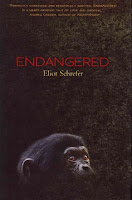Going Up! Elisha Otis's Trip to the Top
by Monica Kulling
Illustrated by David Parkins
Tundra Books, 2012
ISBN: 9781770492400
Grades: 2-5
The reviewers received a copy of the book from the publishers.
Inventors are popular subjects in the biography section. Most biography sections are chock full of books about Benjamin Franklin, Thomas Edison, and Henry Ford. We're fortunate that Monica Kulling sheds light on little known inventors with her Great Idea series. Kulling focuses on the life and work of Elisha Otis and his "people-hoisting machine" (also known as the elevator) in Going Up! Elisha Otis's Trip to the Top.
Kulling engages readers with her narrative style and fast-paced storytelling. She keeps the story moving without leaving out important details. As a librarian who frequently reads aloud picture book biographies to classes, I appreciate that Kulling provides the time period and location on the first page of the story.
"It was 1818, and Elisha Otis was seven. He loved watching farm machines at work.
The hay hoist was the most fun of all. The ropes broke often, and when they did-SNAP!-the hay came tumbling down."
Otis was an idea man. During the construction of a bed-frame factory in Yonkers, Otis worried that heavy machinery would hurt workers if it came crashing down as it was moved to the second floor. Otis invented a safety brake that attached to a platform. It worked so well at moving machinery that Otis decided it would work for moving people. Children who enjoy figuring out how things work will be inspired by Otis's ingenuity.
Detailed pen, ink and watercolor illustrations depict history while also being kid-friendly. Parkins effectively captures the expressions on the faces of people throughout the book. In one illustration, Elisha looks eagerly at his boss who is delighted with Otis's plans for a new bed rail machine. In the background, readers can see the forlorn look on a worker's face as he makes a bed rail by hand.
A note at the end of the book provides more details about Otis's first elevator and how his invention made skyscrapers a possibility. The next time a child needs a biography for a school assignment, pull out Going Up! It is sure to captivate readers while teaching them something new.
_______________________________________________________________________
 An Interview with Monica Kulling
An Interview with Monica Kulling
Louise had the pleasure of interviewing author, Monica Kulling. Kulling is the author of a number of picture book biographies including In the Bag: Margaret Knight Wraps it Up and It's a Snap: George Eastman's First Photograph.
The Nonfiction Detectives: You have written four
books in Tundra’s Great Idea
Series. What drew you to the topic of inventors
Monica: I love reading
about the struggle everyone goes through to achieve his or her goals. Inventors
are clever and ingenious in finding ways to realize their dreams. For me the “aha
moment” is the most fascinating. It’s that moment when a great idea first
clicks in your brain and has you racing off in pursuit.
The first inventor
story I wrote was about George Eastman and his Kodak camera. I shelved the
story after sending it to several publishers and not getting even a nibble. I
then wrote about Henry Ford and his Model T, and sold Eat My Dust! Henry
Ford’s First Race to Random House,
adding Listen Up! Alexander Graham Bell’s Talking Machine to the Step-Into Reading lineup a couple years
later. Then, a fabulous editor at Tundra Books here in Toronto grabbed It’s
A Snap! George Eastman’s First Photograph and the Great Idea
series was born. The picture-book format allows me to bring depth and breadth
to each inventor’s story.
The Nonfiction Detectives: You have written a wide
variety of books for children. Do you prefer writing one genre over another? If
so, why?
Monica: No, I can’t say
that I do. I enjoy writing fiction because there isn’t much research involved
and I can merrily fly by the seat of my pants, inventing away, and nobody can
come along and say, “Hey! That didn’t happen.” I also love biography, giving
kids a peek inside another time and at people whose lives were vastly different
from our own.
The Nonfiction Detectives: Where do you get your
ideas?
Monica: I
have ideas popping up all the time. The best place seems to be while walking my
dogs through High Park, a large city park in Toronto. To quote Dr. Linus
Pauling, “The best way to have a good idea is to have a lot of ideas.” When I
am struck by an idea I jot it down in a handy notepad. Much later, I’ll see
whether any of these ideas still contain a latent spark, an electrical charge.
If so, I’ll pursue it. If not, forget it.
The Nonfiction Detectives: What was your process
for researching this book?
Monica: Going Up! was a strange book to research, because there are
no books about Elisha Otis. I couldn’t tackle the subject in my usual way,
reading widely and choosing facts from several sources. I gleaned all my
information online. But because I had set out to write the story in the same
folksy way as It’s A Snap!, I
felt free to give the facts a supporting role and to focus on the story of a
young man who took years and years to find his groove. Not everyone appreciates
this method of serving up non-fiction. One reviewer, for example, didn’t like
the phrase, “Betsy could almost see the lightbulb over her husband’s head,”
rightly citing it as an anachronism. Oops.
The Nonfiction Detectives: Did you always want to
be a writer?
Monica: No. Writing came to
me quite by accident. In my teens, I needed my own space and a place where I
could get away from day-to-day family life. I took to writing poetry after
being struck, and I know this will sound trite, by the passion and lyricism of
Melanie Safka’s song, “Lay Down (Candles In the Rain).” It was the opening that
blew me away, for some inexplicable reason. The power of it woke me up! And I
started to write.
The Nonfiction Detectives: Do you make your living
as a writer?
Monica: Yes, such as it is.
The Nonfiction Detectives: What is your writing
schedule like? Do you write every morning? Do you have a studio?
Monica: I
have an office and write every morning. I research most afternoons. But I can
write any time, because writing is never far from my mind.
The Nonfiction Detectives: Is there any particular
author or book that influenced you in any way either growing up or as an adult?
Monica: That’s a good
question, and one I can’t easily answer because I wasn’t much of a reader when
I was younger. The few books that made a deep impression on me were the ones I
actually got through in high school, such as Jean Valjean’s story from Les
Miserables, To Kill a Mocking
Bird, Animal Farm, and Steinbeck’s The Red Pony. As for influences today, there are many writers I
read and admire and think, “Wow. I could never write like that.”
The Nonfiction Detectives: What do you hope
readers take away from In the Bag!
and other books in the Great Idea
series?
Monica: I hope readers will
realize that life offers a world of possibilities, and that they can do
whatever they choose to do if they put the time, energy, and will behind the
enterprise. In the case of Elijah McCoy (All Aboard!) and Margaret Knight (In the Bag!), I’d like readers to see that struggle is part of
life and that if you are at a disadvantage by virtue of something beyond your
control, there are ways to overcome that unfairness.
I’d also like them to
know that people living long ago in less comfortable conditions than many of us
enjoy, made a contribution to the way we live our lives today, and these
contributions have nothing to do with anything digital.
The Nonfiction Detectives: What
do you hope readers will take away from Going Up!?
Monica: Again, I hope
readers will come to learn a little about a man who made elevators a reality.
We take those “quiet rooms” for granted whenever we step into one, but all you
have to do is look up to see the “Otis” name. Going Up! will clear up the mystery, just a little, about
who that man was, how he came to invent the safety brake, and what it meant
during his lifetime and what it means to us today.
 You could tie this book with other nonfiction titles about Vietnam, The Vietnam War, Escape from Saigon: a Vietnam War Orphan becomes an American boy by Andrea Warren, and a biography of Muhammand Ali. For fiction, try Fallen Angels by Walter Dean Myers, Free-Fire Zone by Chris Lynch (and other titles in this series), All the Broken Pieces by Ann E. Burg, and The Wall by Eve Bunting. Visit the author's web site.
You could tie this book with other nonfiction titles about Vietnam, The Vietnam War, Escape from Saigon: a Vietnam War Orphan becomes an American boy by Andrea Warren, and a biography of Muhammand Ali. For fiction, try Fallen Angels by Walter Dean Myers, Free-Fire Zone by Chris Lynch (and other titles in this series), All the Broken Pieces by Ann E. Burg, and The Wall by Eve Bunting. Visit the author's web site.








